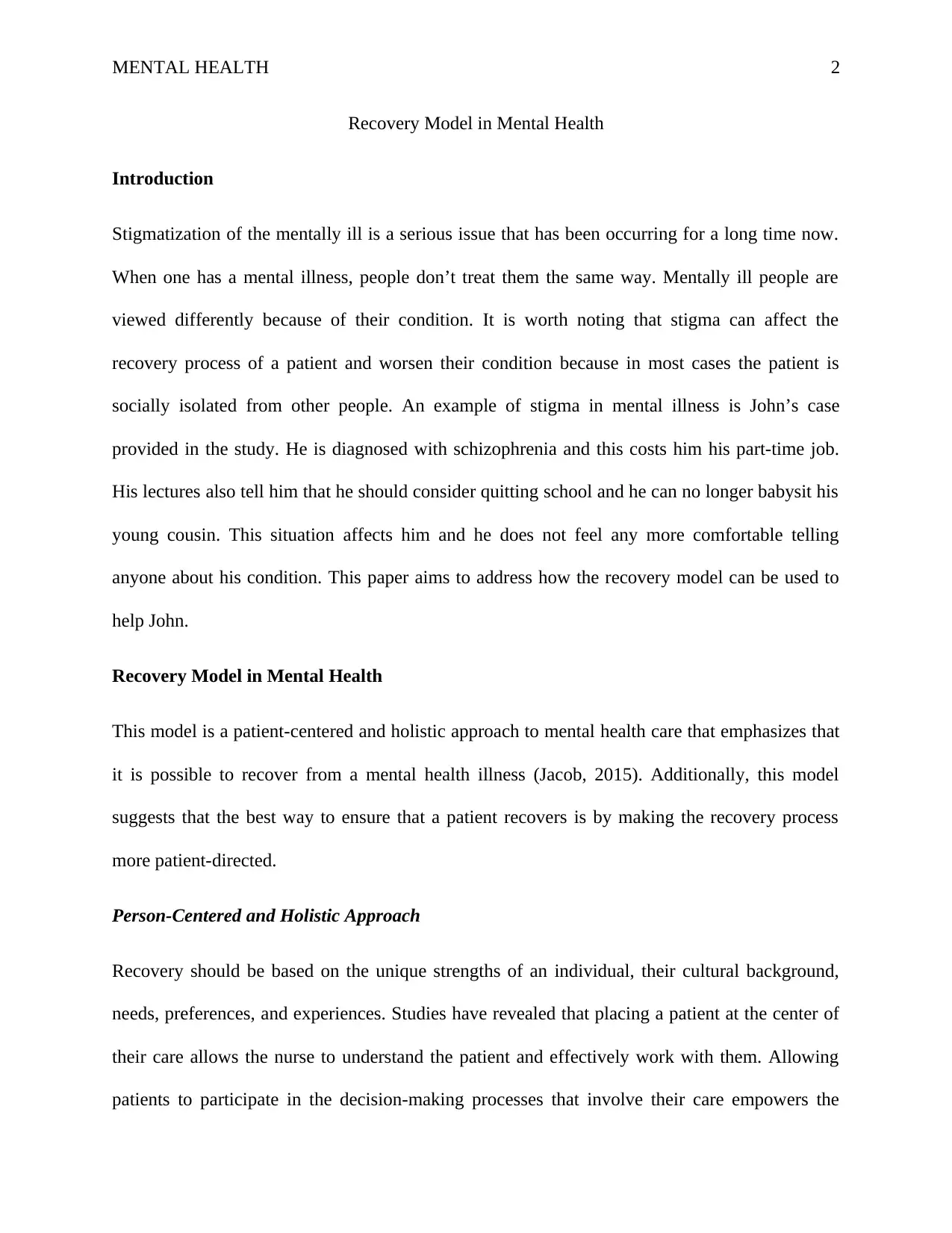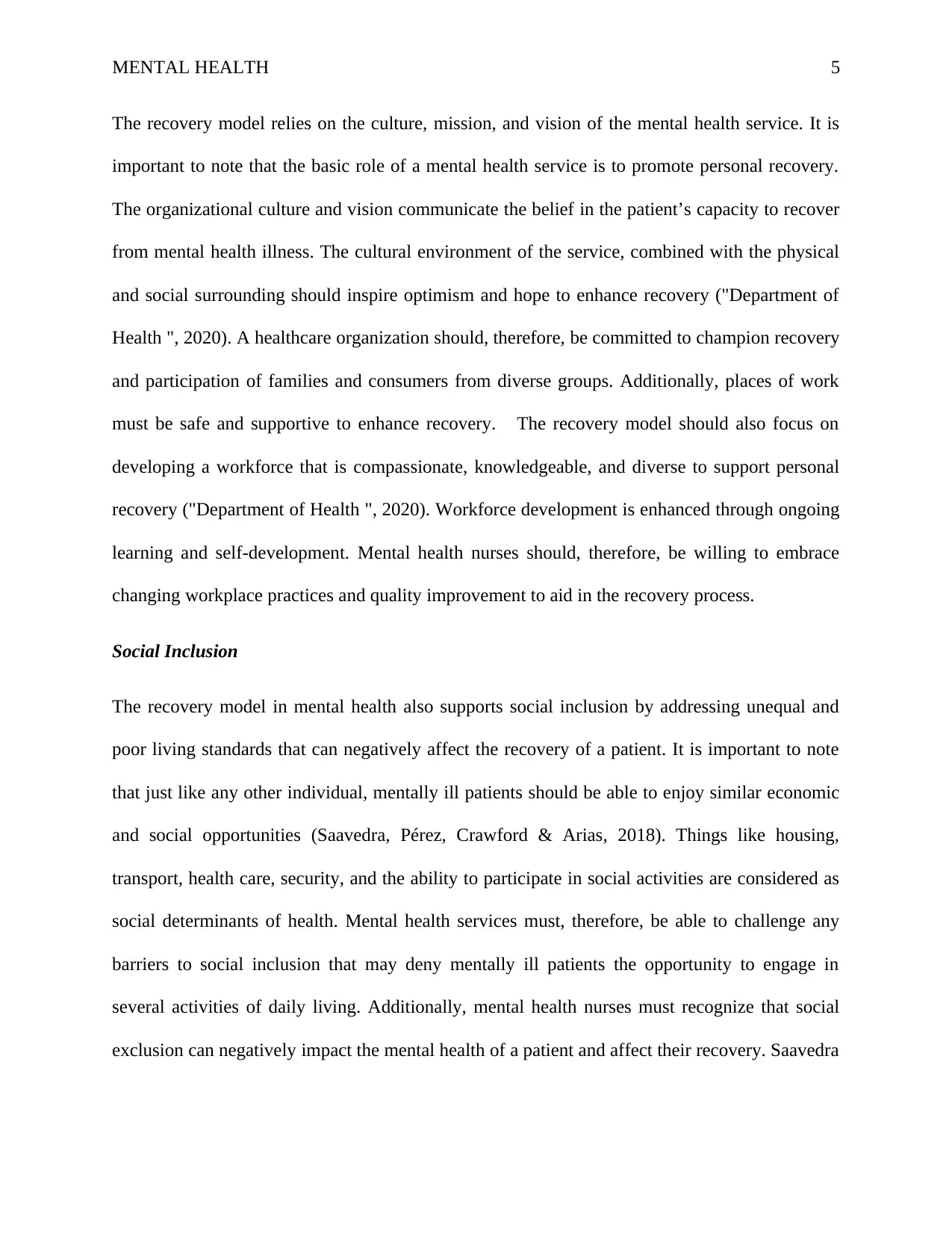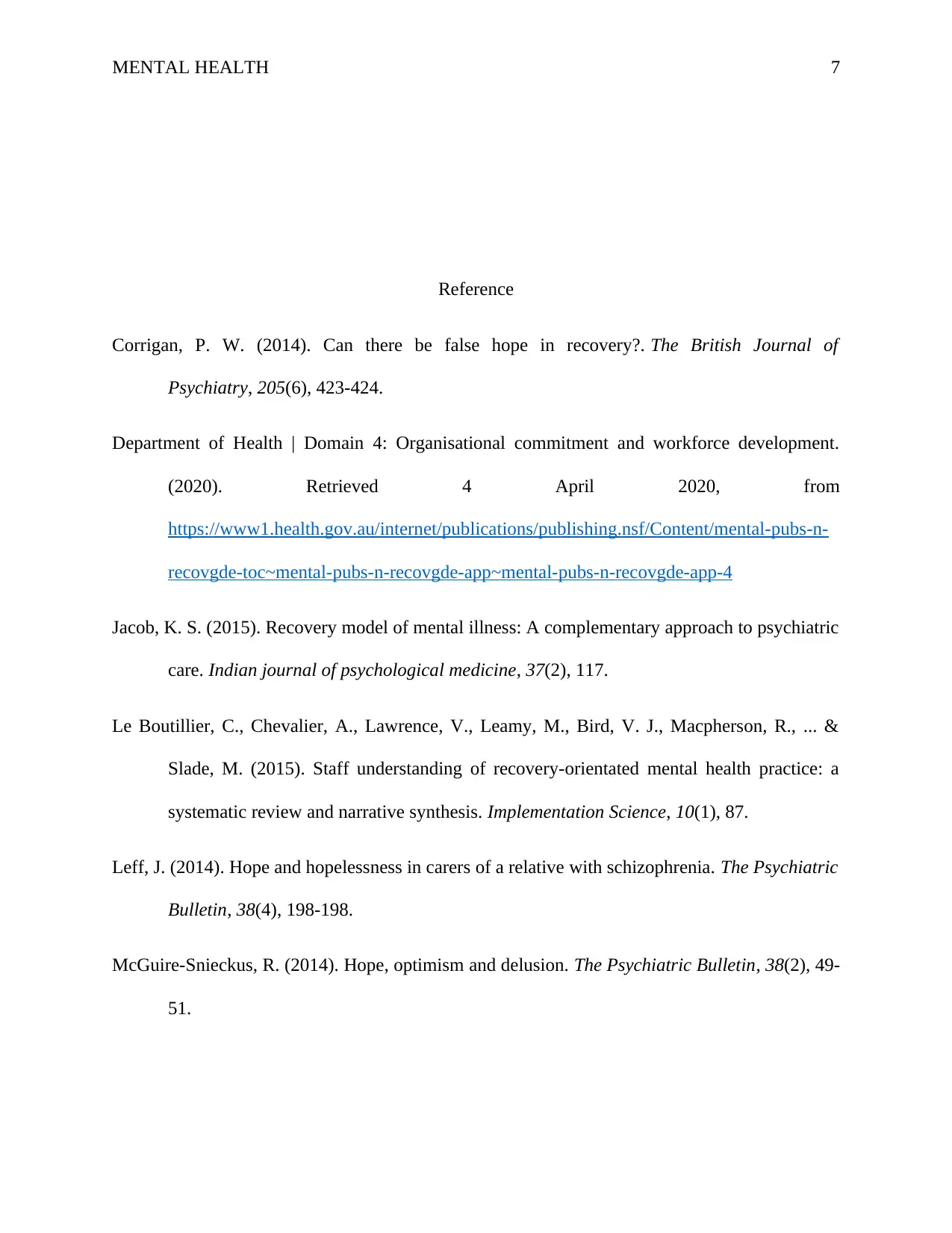Applying the Recovery Model in Mental Health: A Detailed Exploration
VerifiedAdded on 2022/09/13
|8
|1870
|15
Essay
AI Summary
This essay delves into the recovery model in mental health, emphasizing its patient-centered and holistic approach. It highlights the importance of hope, optimism, and personal recovery in the healing process. The essay examines the significance of organizational commitment and workforce development in supporting recovery, along with the crucial role of social inclusion in addressing barriers to mental well-being. It discusses how the recovery model combats the stigma associated with mental illness, promoting a comprehensive approach to care that considers all aspects of a patient's life, including their mind, community, and spirit. The essay references relevant studies to support its claims, ultimately advocating for the widespread adoption of the recovery model to enhance outcomes for individuals with mental health conditions. This model empowers patients to take control of their healing and transform their lives, and it also supports the building of strong support systems for patients which aids in the recovery process.

Running head: MENTAL HEALTH 1
Recovery Model in Mental Health
Name
Institution
Recovery Model in Mental Health
Name
Institution
Paraphrase This Document
Need a fresh take? Get an instant paraphrase of this document with our AI Paraphraser

MENTAL HEALTH 2
Recovery Model in Mental Health
Introduction
Stigmatization of the mentally ill is a serious issue that has been occurring for a long time now.
When one has a mental illness, people don’t treat them the same way. Mentally ill people are
viewed differently because of their condition. It is worth noting that stigma can affect the
recovery process of a patient and worsen their condition because in most cases the patient is
socially isolated from other people. An example of stigma in mental illness is John’s case
provided in the study. He is diagnosed with schizophrenia and this costs him his part-time job.
His lectures also tell him that he should consider quitting school and he can no longer babysit his
young cousin. This situation affects him and he does not feel any more comfortable telling
anyone about his condition. This paper aims to address how the recovery model can be used to
help John.
Recovery Model in Mental Health
This model is a patient-centered and holistic approach to mental health care that emphasizes that
it is possible to recover from a mental health illness (Jacob, 2015). Additionally, this model
suggests that the best way to ensure that a patient recovers is by making the recovery process
more patient-directed.
Person-Centered and Holistic Approach
Recovery should be based on the unique strengths of an individual, their cultural background,
needs, preferences, and experiences. Studies have revealed that placing a patient at the center of
their care allows the nurse to understand the patient and effectively work with them. Allowing
patients to participate in the decision-making processes that involve their care empowers the
Recovery Model in Mental Health
Introduction
Stigmatization of the mentally ill is a serious issue that has been occurring for a long time now.
When one has a mental illness, people don’t treat them the same way. Mentally ill people are
viewed differently because of their condition. It is worth noting that stigma can affect the
recovery process of a patient and worsen their condition because in most cases the patient is
socially isolated from other people. An example of stigma in mental illness is John’s case
provided in the study. He is diagnosed with schizophrenia and this costs him his part-time job.
His lectures also tell him that he should consider quitting school and he can no longer babysit his
young cousin. This situation affects him and he does not feel any more comfortable telling
anyone about his condition. This paper aims to address how the recovery model can be used to
help John.
Recovery Model in Mental Health
This model is a patient-centered and holistic approach to mental health care that emphasizes that
it is possible to recover from a mental health illness (Jacob, 2015). Additionally, this model
suggests that the best way to ensure that a patient recovers is by making the recovery process
more patient-directed.
Person-Centered and Holistic Approach
Recovery should be based on the unique strengths of an individual, their cultural background,
needs, preferences, and experiences. Studies have revealed that placing a patient at the center of
their care allows the nurse to understand the patient and effectively work with them. Allowing
patients to participate in the decision-making processes that involve their care empowers the

MENTAL HEALTH 3
patient thus increasing the probability of recovery (Mezzich et al., 2016). A competent mental
health nurse should be able to listen to the concerns and views of their patient regarding their
preferred treatment. However, sometimes an illness may affect the decision-making capability of
the patient. It is therefore important to prioritize the safety of the patient and explain to them the
best available treatment and care plan (Mezzich et al., 2016). The recovery model also advocates
for a holistic approach that incorporates a patient’s entire life. This includes their mind,
community, and spirit. The process of recovery should embrace all life aspects that include
education, employment, family supports, social networks, and housing among others (Thieme,
Wallace, Meyer & Olivier, 2015). A holistic approach to care works hand in hand with the
patient-centered approach because it considers both mental and social factors rather than just the
symptoms of the illness. A holistic approach also focuses on building strong support systems for
the patients thus aiding in the recovery process and ensuring that recovery is a real possibility.
Hope and Optimism
Hope and optimism are the forces that drive the process of recovery. They provide effective and
motivational messages that suggest the possibility of a positive future. Hope and optimism can
be fostered by friends, families, and peers. The recovery model in mental illness promotes the
culture and language of hope and optimism. Care services for the mentally ill should promote
hope and optimism by encouraging the recovery efforts of the patients through self-
determination and communicating a language of potentiality (Leff, 2014). Mental health nurses
also contribute to the recovery model and promote the recovery process by offering patient-
centered and respectful care that inspires hope and optimism. The recovery model communicates
a language of optimism and hope by relaying positive messages of recovery to patients and their
families. Hope and optimism can also be encouraged by using optimistic language when
patient thus increasing the probability of recovery (Mezzich et al., 2016). A competent mental
health nurse should be able to listen to the concerns and views of their patient regarding their
preferred treatment. However, sometimes an illness may affect the decision-making capability of
the patient. It is therefore important to prioritize the safety of the patient and explain to them the
best available treatment and care plan (Mezzich et al., 2016). The recovery model also advocates
for a holistic approach that incorporates a patient’s entire life. This includes their mind,
community, and spirit. The process of recovery should embrace all life aspects that include
education, employment, family supports, social networks, and housing among others (Thieme,
Wallace, Meyer & Olivier, 2015). A holistic approach to care works hand in hand with the
patient-centered approach because it considers both mental and social factors rather than just the
symptoms of the illness. A holistic approach also focuses on building strong support systems for
the patients thus aiding in the recovery process and ensuring that recovery is a real possibility.
Hope and Optimism
Hope and optimism are the forces that drive the process of recovery. They provide effective and
motivational messages that suggest the possibility of a positive future. Hope and optimism can
be fostered by friends, families, and peers. The recovery model in mental illness promotes the
culture and language of hope and optimism. Care services for the mentally ill should promote
hope and optimism by encouraging the recovery efforts of the patients through self-
determination and communicating a language of potentiality (Leff, 2014). Mental health nurses
also contribute to the recovery model and promote the recovery process by offering patient-
centered and respectful care that inspires hope and optimism. The recovery model communicates
a language of optimism and hope by relaying positive messages of recovery to patients and their
families. Hope and optimism can also be encouraged by using optimistic language when
⊘ This is a preview!⊘
Do you want full access?
Subscribe today to unlock all pages.

Trusted by 1+ million students worldwide

MENTAL HEALTH 4
communicating with patients. McGuire-Snieckus (2014) states that hope and optimism are key in
the recovery process from mental illness. It is therefore important to encourage patients to avoid
negative thoughts that may be unhelpful in recovery. However, excessive hope and optimism
may negatively affect the recovery process (Corrigan, 2014).
Personal Recovery
The recovery model in mental health should also support personal recovery. The model should
allow a patient to exercise personal control and self-determination by making decisions and
growing with experience. Through the recovery model, nurses must ensure that their interaction
with patients encourages self-control thus aiding in personal recovery. The patients must also be
included in the decision-making and considered as partners in care plans. This inclusion in the
care plan ensures that a patient is in control of their healing thus promoting personal recovery
(Le Boutillier et al., 2015). The recovery model also focuses on the strengths of patients and
supports their capacity for self-advocacy and personal responsibility that can impact positive
change. The recovery model in mental illness implies that patients can recover from mental
illnesses and transform their lives. Additionally, through personal recovery, a patient takes
charge of the therapeutic relationship that aids in their recovery. Practitioners should, therefore,
show that they believe in patients to shape their lives and achieve their aspirations (Williams et
al., 2015). The recovery model also supports mutually respectful relationships that allow mental
health nurses to support patients to build their lives during recovery in ways that the patients see
fit. The practitioners should, therefore, be able to adapt to the changing needs of their patients.
Organizational Commitment and Workforce Development
communicating with patients. McGuire-Snieckus (2014) states that hope and optimism are key in
the recovery process from mental illness. It is therefore important to encourage patients to avoid
negative thoughts that may be unhelpful in recovery. However, excessive hope and optimism
may negatively affect the recovery process (Corrigan, 2014).
Personal Recovery
The recovery model in mental health should also support personal recovery. The model should
allow a patient to exercise personal control and self-determination by making decisions and
growing with experience. Through the recovery model, nurses must ensure that their interaction
with patients encourages self-control thus aiding in personal recovery. The patients must also be
included in the decision-making and considered as partners in care plans. This inclusion in the
care plan ensures that a patient is in control of their healing thus promoting personal recovery
(Le Boutillier et al., 2015). The recovery model also focuses on the strengths of patients and
supports their capacity for self-advocacy and personal responsibility that can impact positive
change. The recovery model in mental illness implies that patients can recover from mental
illnesses and transform their lives. Additionally, through personal recovery, a patient takes
charge of the therapeutic relationship that aids in their recovery. Practitioners should, therefore,
show that they believe in patients to shape their lives and achieve their aspirations (Williams et
al., 2015). The recovery model also supports mutually respectful relationships that allow mental
health nurses to support patients to build their lives during recovery in ways that the patients see
fit. The practitioners should, therefore, be able to adapt to the changing needs of their patients.
Organizational Commitment and Workforce Development
Paraphrase This Document
Need a fresh take? Get an instant paraphrase of this document with our AI Paraphraser

MENTAL HEALTH 5
The recovery model relies on the culture, mission, and vision of the mental health service. It is
important to note that the basic role of a mental health service is to promote personal recovery.
The organizational culture and vision communicate the belief in the patient’s capacity to recover
from mental health illness. The cultural environment of the service, combined with the physical
and social surrounding should inspire optimism and hope to enhance recovery ("Department of
Health ", 2020). A healthcare organization should, therefore, be committed to champion recovery
and participation of families and consumers from diverse groups. Additionally, places of work
must be safe and supportive to enhance recovery. The recovery model should also focus on
developing a workforce that is compassionate, knowledgeable, and diverse to support personal
recovery ("Department of Health ", 2020). Workforce development is enhanced through ongoing
learning and self-development. Mental health nurses should, therefore, be willing to embrace
changing workplace practices and quality improvement to aid in the recovery process.
Social Inclusion
The recovery model in mental health also supports social inclusion by addressing unequal and
poor living standards that can negatively affect the recovery of a patient. It is important to note
that just like any other individual, mentally ill patients should be able to enjoy similar economic
and social opportunities (Saavedra, Pérez, Crawford & Arias, 2018). Things like housing,
transport, health care, security, and the ability to participate in social activities are considered as
social determinants of health. Mental health services must, therefore, be able to challenge any
barriers to social inclusion that may deny mentally ill patients the opportunity to engage in
several activities of daily living. Additionally, mental health nurses must recognize that social
exclusion can negatively impact the mental health of a patient and affect their recovery. Saavedra
The recovery model relies on the culture, mission, and vision of the mental health service. It is
important to note that the basic role of a mental health service is to promote personal recovery.
The organizational culture and vision communicate the belief in the patient’s capacity to recover
from mental health illness. The cultural environment of the service, combined with the physical
and social surrounding should inspire optimism and hope to enhance recovery ("Department of
Health ", 2020). A healthcare organization should, therefore, be committed to champion recovery
and participation of families and consumers from diverse groups. Additionally, places of work
must be safe and supportive to enhance recovery. The recovery model should also focus on
developing a workforce that is compassionate, knowledgeable, and diverse to support personal
recovery ("Department of Health ", 2020). Workforce development is enhanced through ongoing
learning and self-development. Mental health nurses should, therefore, be willing to embrace
changing workplace practices and quality improvement to aid in the recovery process.
Social Inclusion
The recovery model in mental health also supports social inclusion by addressing unequal and
poor living standards that can negatively affect the recovery of a patient. It is important to note
that just like any other individual, mentally ill patients should be able to enjoy similar economic
and social opportunities (Saavedra, Pérez, Crawford & Arias, 2018). Things like housing,
transport, health care, security, and the ability to participate in social activities are considered as
social determinants of health. Mental health services must, therefore, be able to challenge any
barriers to social inclusion that may deny mentally ill patients the opportunity to engage in
several activities of daily living. Additionally, mental health nurses must recognize that social
exclusion can negatively impact the mental health of a patient and affect their recovery. Saavedra

MENTAL HEALTH 6
et al. (2018) argue that social inclusion is a very critical health determinant that can have several
impacts on personal recovery due to a culture of inequality and inequity in the community.
Conclusion
Mental health is very important in the wellbeing of an individual. However most mentally ill
patients constantly face stigma thus affecting their recovery process. The recovery model is
therefore very important in addressing mental illness and enhancing healing. It focuses on a
holistic and patient-centered approach that supports personal recovery. Personal recovery is
enhanced by believing in the patient’s capacity to shape their own lives. The recovery model also
advocates for social inclusion to enhance healing. The model is therefore very effective in
recovering from a mental illness and fighting stigma.
et al. (2018) argue that social inclusion is a very critical health determinant that can have several
impacts on personal recovery due to a culture of inequality and inequity in the community.
Conclusion
Mental health is very important in the wellbeing of an individual. However most mentally ill
patients constantly face stigma thus affecting their recovery process. The recovery model is
therefore very important in addressing mental illness and enhancing healing. It focuses on a
holistic and patient-centered approach that supports personal recovery. Personal recovery is
enhanced by believing in the patient’s capacity to shape their own lives. The recovery model also
advocates for social inclusion to enhance healing. The model is therefore very effective in
recovering from a mental illness and fighting stigma.
⊘ This is a preview!⊘
Do you want full access?
Subscribe today to unlock all pages.

Trusted by 1+ million students worldwide

MENTAL HEALTH 7
Reference
Corrigan, P. W. (2014). Can there be false hope in recovery?. The British Journal of
Psychiatry, 205(6), 423-424.
Department of Health | Domain 4: Organisational commitment and workforce development.
(2020). Retrieved 4 April 2020, from
https://www1.health.gov.au/internet/publications/publishing.nsf/Content/mental-pubs-n-
recovgde-toc~mental-pubs-n-recovgde-app~mental-pubs-n-recovgde-app-4
Jacob, K. S. (2015). Recovery model of mental illness: A complementary approach to psychiatric
care. Indian journal of psychological medicine, 37(2), 117.
Le Boutillier, C., Chevalier, A., Lawrence, V., Leamy, M., Bird, V. J., Macpherson, R., ... &
Slade, M. (2015). Staff understanding of recovery-orientated mental health practice: a
systematic review and narrative synthesis. Implementation Science, 10(1), 87.
Leff, J. (2014). Hope and hopelessness in carers of a relative with schizophrenia. The Psychiatric
Bulletin, 38(4), 198-198.
McGuire-Snieckus, R. (2014). Hope, optimism and delusion. The Psychiatric Bulletin, 38(2), 49-
51.
Reference
Corrigan, P. W. (2014). Can there be false hope in recovery?. The British Journal of
Psychiatry, 205(6), 423-424.
Department of Health | Domain 4: Organisational commitment and workforce development.
(2020). Retrieved 4 April 2020, from
https://www1.health.gov.au/internet/publications/publishing.nsf/Content/mental-pubs-n-
recovgde-toc~mental-pubs-n-recovgde-app~mental-pubs-n-recovgde-app-4
Jacob, K. S. (2015). Recovery model of mental illness: A complementary approach to psychiatric
care. Indian journal of psychological medicine, 37(2), 117.
Le Boutillier, C., Chevalier, A., Lawrence, V., Leamy, M., Bird, V. J., Macpherson, R., ... &
Slade, M. (2015). Staff understanding of recovery-orientated mental health practice: a
systematic review and narrative synthesis. Implementation Science, 10(1), 87.
Leff, J. (2014). Hope and hopelessness in carers of a relative with schizophrenia. The Psychiatric
Bulletin, 38(4), 198-198.
McGuire-Snieckus, R. (2014). Hope, optimism and delusion. The Psychiatric Bulletin, 38(2), 49-
51.
Paraphrase This Document
Need a fresh take? Get an instant paraphrase of this document with our AI Paraphraser

MENTAL HEALTH 8
Mezzich, J. E., Botbol, M., Christodoulou, G. N., Cloninger, C. R., & Salloum, I. M. (2016).
Introduction to person-centered psychiatry. In Person centered psychiatry (pp. 1-15).
Springer, Cham.
Saavedra, J., Pérez, E., Crawford, P., & Arias, S. (2018). Recovery and creative practices in
people with severe mental illness: evaluating well-being and social inclusion. Disability
and rehabilitation, 40(8), 905-911.
Thieme, A., Wallace, J., Meyer, T. D., & Olivier, P. (2015). Designing for mental wellbeing:
towards a more holistic approach in the treatment and prevention of mental illness.
In Proceedings of the 2015 British HCI Conference (pp. 1-10).
Williams, J., Leamy, M., Bird, V., Le Boutillier, C., Norton, S., Pesola, F., & Slade, M. (2015).
Development and evaluation of the INSPIRE measure of staff support for personal
recovery. Social psychiatry and psychiatric epidemiology, 50(5), 777-786.
Mezzich, J. E., Botbol, M., Christodoulou, G. N., Cloninger, C. R., & Salloum, I. M. (2016).
Introduction to person-centered psychiatry. In Person centered psychiatry (pp. 1-15).
Springer, Cham.
Saavedra, J., Pérez, E., Crawford, P., & Arias, S. (2018). Recovery and creative practices in
people with severe mental illness: evaluating well-being and social inclusion. Disability
and rehabilitation, 40(8), 905-911.
Thieme, A., Wallace, J., Meyer, T. D., & Olivier, P. (2015). Designing for mental wellbeing:
towards a more holistic approach in the treatment and prevention of mental illness.
In Proceedings of the 2015 British HCI Conference (pp. 1-10).
Williams, J., Leamy, M., Bird, V., Le Boutillier, C., Norton, S., Pesola, F., & Slade, M. (2015).
Development and evaluation of the INSPIRE measure of staff support for personal
recovery. Social psychiatry and psychiatric epidemiology, 50(5), 777-786.
1 out of 8
Related Documents
Your All-in-One AI-Powered Toolkit for Academic Success.
+13062052269
info@desklib.com
Available 24*7 on WhatsApp / Email
![[object Object]](/_next/static/media/star-bottom.7253800d.svg)
Unlock your academic potential
Copyright © 2020–2025 A2Z Services. All Rights Reserved. Developed and managed by ZUCOL.





